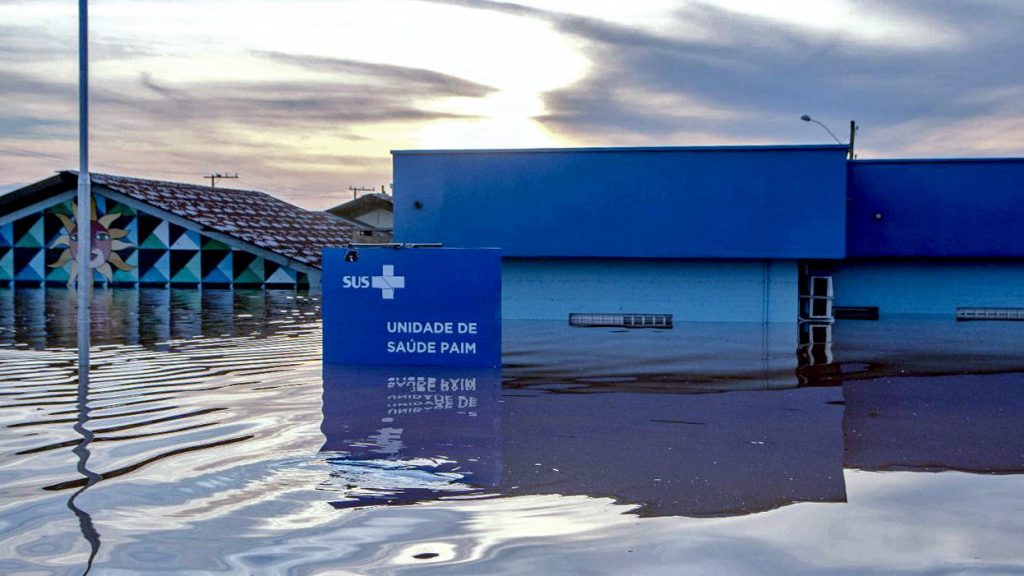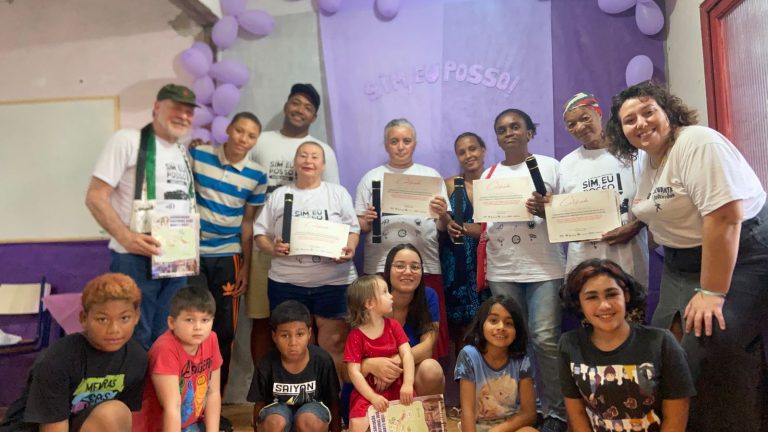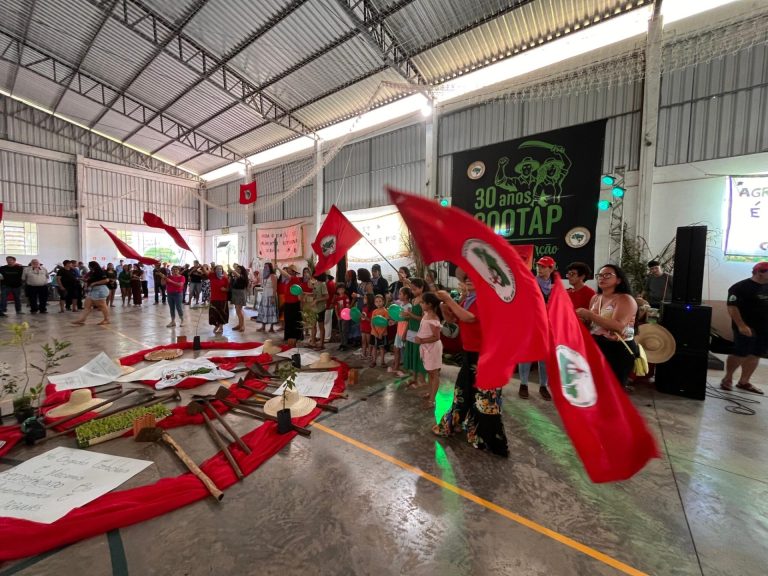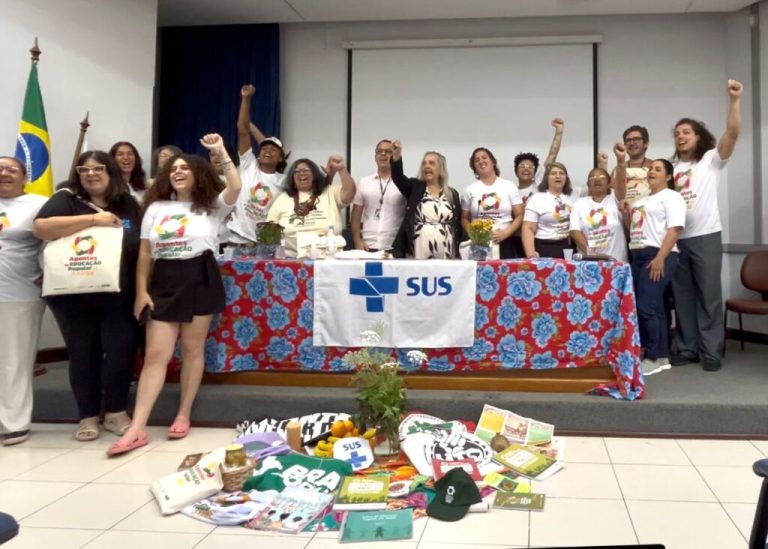Rio Grande do Sul
Population of Rio Grande do Sul still faces major obstacles to healthcare access after devastating floods
A health administrator from Rio Grande do Sul analyzes the state’s situation and sees a lack of coordination and the risk of misusing public funds in the upcoming municipal elections

By Outra Saúde*
From Peoples Dispatch**
The devastating floods in Rio Grande do Sul have left a profound impact on the region, Dr. Rosângela Dornelles, a family and community doctor, told Outra Saúde. She describes being stranded at her hospital, navigating flooded areas by boat and tractor, and witnessing the extensive damage and suffering firsthand. Previously interested in working in international disaster zones, she found herself facing a catastrophe in her own community.
Dr. Dornelles looks at the state government’s response, highlighting the inefficiencies caused by outsourcing management within the health system. She calls for a more coordinated effort, including the creation of an Emergency Operations Center and better use of the SUS (Brazilian Unified Health System) to organize aid distribution and ensure quicker responses.
She emphasizes the need to strengthen primary care, improve coordination with specialized care, and combat outsourcing to enhance the overall health system. The floods have also led to the exhaustion of both health professionals and the system itself, drawing parallels to the COVID-19 pandemic.
Outra Saúde: What is the state of public and collective health in Rio Grande do Sul (RS), close to two months after the catastrophe that struck the state? RS is still experiencing the after-effects of the floods, including the threat of them returning to several cities. How is the physical structure of health facilities?
Rosângela Dornelles: The environmental disaster of May 2024 has deepened a health crisis that had been ongoing since the pandemic, exacerbated by long-standing underfunding of public health and the failure to strengthen the SUS. The floods have exposed the vulnerabilities of the management model adopted by the state and affected municipalities, characterized by extensive outsourcing of the health network, particularly in primary care, where we provide the most immediate assistance to the population.
We are witnessing an almost indescribable tragedy, with entire towns destroyed, creating a sense of displacement and loss, as if the territory ceased to exist from one moment to the next. Thousands of people have lost their homes, and the damage is so extensive that local authorities struggle to manage it. Food insecurity is rampant, and many children and teenagers cannot attend schools that have also been destroyed. This has led to increased mental health care needs among the victims.
From a health perspective, there is a significant lack of intersectoral actions, which could be addressed through close collaboration with social movements, universities, and the communities themselves. The climate emergency has heightened the vulnerability of indigenous, quilombola, and LGBTQIA+ populations, revealing the shortcomings of fragmented public policies over the years.
The floods have led to contamination and health issues such as respiratory diseases and leptospirosis due to contact with floodwaters. The devastation reminds me of a scorched earth scenario. I am from Eldorado do Sul, near Porto Alegre, a town that was totally submerged. Going there now is like traveling to one of those towns from the Wild West in old movies, where people never go back to.
It’s a scene of destruction and a health emergency. Public health efforts must urgently reaffirm the intersectoral nature of the SUS and highlight the social determinants of health we are literally living through now. It is crucial to re-establish the minimum guarantee that the right to health is a state responsibility. I’m saying this because, even with the increased presence of the federal government, the state must not neglect its duty to structure services and organize the municipalities. The SUS has a tripartite structure; in addition to management and financing, it is also responsible for making decisions and implementing health policies. We need to reaffirm the SUS’s federative and universal structure.
OS: How do you assess the actions of public authorities in promoting and guaranteeing health, especially in their direct interaction with users of health services, given the infections and assistance required at this moment, in a context where the physical health structures themselves are devastated?
RD: To explain this, I need to address the issue of outsourcing and the management model implemented in recent years. This model does not engage with local territories and fragments the execution of more effective actions that ensure comprehensive care and a cohesive health network. We observe very uncoordinated actions across all sectors. The SUS is designed to coordinate surveillance and implement actions, such as georeferencing and matrix support, which are currently lacking. The National SUS Force and state employees could assist with this, but the former State SUS Force in Rio Grande do Sul has been deactivated.
There is a clear disconnect, and it seems the state government does not take responsibility for health. The state only disseminates basic information such as weather alerts and the number of displaced or homeless people. We need a more coordinated approach to formulating and implementing reconstruction actions. Otherwise, we risk failing to optimize the federal government’s investment and addressing the health needs arising from this climate emergency.
We should establish a state Emergency Operations Center (COE) to facilitate coordinated actions and responses, involving a broader range of stakeholders. This COE should not only provide information but also develop proposals and implement changes. We need a more accurate diagnosis of health care needs. Sometimes, it seems like the municipalities do not know their own people. Some of them even struggle to register families for financial aid and other programs because they lack proper management and knowledge of their residents.
Some cities have Community Health Workers, who can help organize health programs since they are allowed to enter homes and understand the local reality, serving as a georeference. If municipalities utilized the state’s resources and the information produced by primary care, we would see faster responses. However, the outsourcing model fragments relationships. For example, in a health unit in Porto Alegre, you might find a nurse hired by a company, a civil servant, and a temporary contractor—all with different terms of employment. This variety in hiring practices undermines the effectiveness of comprehensive care management.
OS: What is the intersection between public and private health in the state? How come part of the federal funds can be lost to the private sector?
RD: In our state, the hospital network comprises nearly 80% of SUS beds, and it also serves the private sector. We must ensure that investments are genuinely allocated to the SUS, preventing the private sector from using public money to strengthen itself without expanding services for the public health system. It’s not just about providing funds, but also about how these funds are used. Otherwise, we risk expanding the number of beds and care capacity solely in the private sector, which is a common issue across Brazil.
It’s not just about increasing services; it’s about integrating into the SUS network too, engaging in dialogue, training staff to provide more humanized care, and ensuring that people are genuinely part of the contracted structures. This includes not just service provision, but the entire health network infrastructure.
The involvement of the Public Prosecutor’s Office is crucial because currently, the state is unable or unwilling to manage this effectively. The state often grants exemptions and makes no investments.
OS: During the pandemic, a major threat, which sometimes materialized, was the overload and consequent collapse of health services. Is this happening now in Rio Grande do Sul?
RD: I think we’ve moved beyond mere overload; it’s already a tragedy. When people can’t access timely healthcare and are put on waiting lists, it shows that health workers are not in a position to keep up. Overload was what existed before the pandemic, with many people waiting, especially for specialized care. Now, we’re experiencing chaos in the restructuring of health networks and the challenge of rebuilding after a disaster that has destroyed cities.
When a health unit or emergency room is destroyed, people lose their point of reference. But the issue of being present in the territory remains. As family health doctors, we need to be in the community to serve people, not just rely on the structure of the health unit. We need to understand people’s needs, even if it means providing care in a church or a room in a building, which is often all that remains in some cities.
Currently, there is a loss of reference points in the health system. People don’t know who to turn to for help, how to identify problems, or where to find solutions in both primary and specialized care. If someone has severe symptoms, they go to a specialist. But if they have a serious diagnosis, who will provide care amid all this chaos? Is there a guarantee of timely care? The overcrowding of emergency rooms is evident. Emergency Care Units (UPAs) have basically become stationary beds: they are filled with patients who should already be hospitalized for procedures.
We’re facing chaos in terms of care. The disaster has worsened the overload, and people are being neglected as a result of that.
Research shows that nearly 100% of the population has some kind of mental health issue—depression, anxiety, panic. I’ve had patients say, “Doctor, I’m very nervous. I wasn’t affected by the flood, but I feel guilty for living well while others suffer. I helped as much as I could, donating sheets, food, and money.” People come to service stations at dawn, overwhelmed by their own situations, unaware that others are dealing with similar feelings.
Today, our “pandemic” is mental health. In addition to the lack of care for physical needs, such as respiratory and infectious diseases, there is an obscure epidemic of mental health issues, which overloads health services. Many people visit clinics due to anxiety, and this overload affects health workers too, creating a vicious cycle. I think we’ve moved from overload to chaos.
There’s a loss of control over waiting times for various procedures. There’s a waiting list that’s in the system, there’s a surgical waiting list that may be internal to the hospital, there may be a waiting list within primary care for a simple procedure… There is not always clarity about this, and the fragmentation of the system is worsened by outsourcing and the discontinuity of professionals in the SUS. One day a professional is trained, the next day another. They stay for six months to understand how the system works, but then they leave and so on.
In my town, a new health center funded by a parliamentary amendment remains unoccupied because the town hall hasn’t completed the necessary adjustments. Who supervises this? Who communicates with these officials? Meanwhile, the population receives poor service in another, makeshift location. The situation we are in requires a deep understanding of social suffering. We need to consider what people go through to access healthcare, whether they get home visits, and whether they can actually get the exams and treatments they need.
On top of that, we’re dealing with a necropolitical disorder, exacerbated by denialism during the pandemic, which worsened waiting times. Outsourcing has further distanced professionals from the local community, a relationship that could have been strengthened instead.
OS: How should SUS managers across Brazil view this tragedy?
RD: The response to this flood tragedy should begin with strengthening the SUS. This involves securing the federal health budget, a current topic of debate, as without it, we cannot reaffirm the idea that the health system serves everyone, with strong social control and greater societal participation. We must prioritize the defense of life and the social function of the health system.
Key actions include building the COE and involving the Public Prosecutor’s Office. The fundamental goal is to make the SUS a model for defending life, ensuring universal access, and respecting diversity throughout its construction and management.
We need accurate diagnostics on all levels. I doubt if the state’s leaders even know how much hemodialysis supplies are needed today or their costs. This information could be part of a project to create alternatives that reduce costs and increase access to treatment, aligning with the Health Industrial Economic Complex project. A universal system must guarantee diversity, health sovereignty, and recognize the SUS as a major driver of socio-economic development.
This discussion needs to reach the National Health Council and Congress, because similar events will happen again, here and elsewhere. We need to talk about proactive solutions. Climate change is evident; we experience extreme weather conditions simultaneously, like lightning, torrential rain, and sun. Imagine the level of climate change we are already facing, similar to other countries.
This situation is overwhelming. I was trapped in the hospital for a week, unable to go home, navigating the flooded city by boat. I had always wanted to work for Médecins Sans Frontières in disaster zones we see on TV, but I ended up experiencing such situations here at home. I crossed the city by boat, rode a tractor, and did whatever was necessary to reach my destination. On weekends, I visited quilombo communities and other metropolitan areas, of which I know a lot about thanks to my experience as a former deputy secretary and regional health coordinator for the State Health Department.
We almost ran out of oxygen, had just a 24-hour supply, transported patients by helicopter, and I spent seven days confined inside the hospital during the initial days of the flood. The reality is tragic; it’s a social reconstruction effort of overwhelming dimensions. It’s very challenging.
*The interview with Rosângela Dornelles was conducted by Gabriel Brito, and published in Portuguese on Outra Saúde.
**People’s Health Dispatch is a fortnightly bulletin published by the People’s Health Movement and Peoples Dispatch. For more articles and to subscribe to People’s Health Dispatch, click here.



